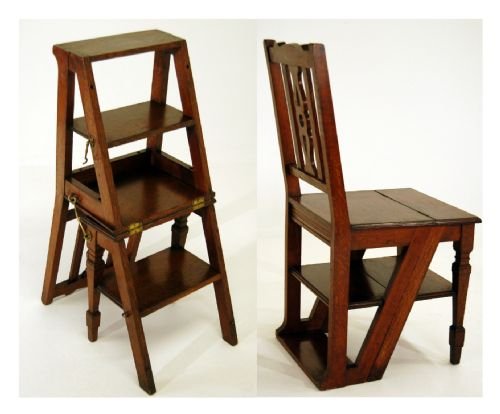It's time I made something again. I don't have the excuse that it's too cold - my workshop is in the basement, and although it's very well ventilated (to make sure there is plenty of air for the gas boiler) it stays at around 15° which suits me fine.
I have decided to make a chair which converts into a pair of steps. It's not an original idea - there was one on this threadquite recently. I want to use a slightly older design, from a reprint of Paul Hasluck's 1903 Handyman's Book.
This is what it should look like:


I have some suitable wood, which used to be the sides of a small (broken) Victorian cupboard that some neighbours were throwing out. I thought that inch thick boards 15" x 60" were too good to throw away:

I'm not sure what wood it is - maybe walnut? It's quite soft, and does not have very interesting grain, but works beautifully.
I spent quite a long time making a full-size drawing, on a piece of lining paper, so as to understand the construction properly and work out the sizes of everything. I then wrote out a cutting list and planned how to get all the bits out of my two boards. On paper, there was enough wood.
Planning it out for real, there were a few flaws to be worked around - a knot, screw holes for hinges, and a join along one of the boards, but there was still just enough.


A little bit of sawing later, and I had a pile of bits.

I thought I would start with the long back legs. Disaster!
I had accurately laid out and cut all the parts that were on my cutting list - but these should have been 36" long. On my list they were 32" - and that's what I have. There is no sensible way I can lengthen the main structural piece - and indeed, not enough wood now. I shall just have to make some more, out of some other wood. It won't quite match, but maybe I can find something close enough.
There will now be a pause in this project while I try to cheer myself up, and ask if there is any suitable advice about how many times to measure before cutting or anything like that!
I have decided to make a chair which converts into a pair of steps. It's not an original idea - there was one on this threadquite recently. I want to use a slightly older design, from a reprint of Paul Hasluck's 1903 Handyman's Book.
This is what it should look like:


I have some suitable wood, which used to be the sides of a small (broken) Victorian cupboard that some neighbours were throwing out. I thought that inch thick boards 15" x 60" were too good to throw away:

I'm not sure what wood it is - maybe walnut? It's quite soft, and does not have very interesting grain, but works beautifully.
I spent quite a long time making a full-size drawing, on a piece of lining paper, so as to understand the construction properly and work out the sizes of everything. I then wrote out a cutting list and planned how to get all the bits out of my two boards. On paper, there was enough wood.
Planning it out for real, there were a few flaws to be worked around - a knot, screw holes for hinges, and a join along one of the boards, but there was still just enough.


A little bit of sawing later, and I had a pile of bits.

I thought I would start with the long back legs. Disaster!
I had accurately laid out and cut all the parts that were on my cutting list - but these should have been 36" long. On my list they were 32" - and that's what I have. There is no sensible way I can lengthen the main structural piece - and indeed, not enough wood now. I shall just have to make some more, out of some other wood. It won't quite match, but maybe I can find something close enough.
There will now be a pause in this project while I try to cheer myself up, and ask if there is any suitable advice about how many times to measure before cutting or anything like that!







































